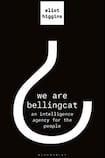
An RTÉ advertisement regularly warns, in eerie animation, of the shadowy world of internet sources. It seems a suitable prelude to a book on the brave new world of “citizen” journalism, with the brand name Bellingcat.
The irony is Bellingcat would probably subject RTÉ itself to the scrutiny it applies to shadowy forces: that national broadcasters are not immune to spin and propaganda is a basic tenet of its searing exposés.
Russian defector Sergei Skripal and his daughter Yulia were poisoned in Salisbury in 2019 by Russian agents, as was leading Russian opposition activist Alexei Navalny (currently re-imprisoned) last year. Malaysian civilian airplane MH17 was shot down in 2014 by a Russian missile. The cluster bombs which killed innocent Syrian civilians were launched by the Syrian regime itself. All Bellingcat exposés.
Not so well known are their many other success stories including the conviction of white supremacists involved in the violent riots at Charlottesville and the charging of war criminals.
Bellingcat is now a recognised investigative force, but it began as the singular mission of its founder Eliot Higgins. An admirer of Mark Little’s Storyful, which pioneered the monitoring of social media for facts, in his spare time, in his spare room, he turned his passion for uncovering disinformation into a powerful new journalism,
So why wasn’t mainstream media getting the same results? It all comes back to those eerie animations. To the shock of the new in media; the internet.
Donald Trump, with his malevolent mastery of the newest, fastest means of communication, Twitter, provided a wake-up call
The technological revolution of the past 20 years was on a scale unlike anything encountered in the 20th century. Its sheer pace bewildered traditional media and understandably the reaction ran the gamut from head in the sand to holding the enemy close.
Some news organisations saw its potential. The Guardian, where Higgins cut his teeth on “citizen” journalism platforms, began to publish online as well as in print. Others reluctantly followed. The internet as a new forum for publishing, providing content free of charge, was the extent of their vision. In spite of this – or perhaps because of it – media was in the doldrums,
Donald Trump, with his malevolent mastery of the newest, fastest means of communication, Twitter, provided a wake-up call. His “fake news” demagoguery galvanised a media debilitated by the financial losses caused by supplying news content free. They began hiring again. But traditional, “closed source” methods, where journalists cultivate “reliable” sources who reveal what powerful people prefer to hide, were often no match for the tsunami of disinformation that destabilised an already unstable world.
Higgins realised there was a wealth of good information, what he calls “open” sources, also available. His genius lay in figuring out how to use it.
He understood that research, investigation, verification and reporting can be achieved using the same keystrokes. The answers to most questions can be found if you know where to look. Mapping social media posts from the public alongside mainstream news proved a powerful tool.
This marrying of technology and creativity with the traditional values of journalism was revolutionary. That old cliche about genius being one part inspiration and 99 parts perspiration was never more applicable.
We Are Bellingcat is a thrilling, if demanding, read. Verification of countless videos and posts from crime scenes was their main modus operandi. Bellingcat found itself interested in the big crimes – the Syrian civil war, Russian interference in democratic states, the growth of nationalism on both the far right and far left – because that was where most of the disinformation lay. To say the task was painstaking is an epic understatement.
Some of Bellingcat's methods, such as occasionally paying for data, can be criticised
Their verifications often started with the geographical: like native American scouts they proved videos were faked from shadow patterns on the landscape. they picked up trails on voices and photographs. Word patterns on posts led them to international troll factories,
Exhaustive and exhausting, nonetheless Higgins Eliot soon had the co-operation of a like-minded community across the globe including Storyful’s Malachy Browne from Limerick, who now leads the New York Times award winning visual investgations team.
Some of Bellingcat’s methods, such as occasionally paying for data, can be criticised. But their ethic borders on the Hippocratic. Realising that, once alerted by publication, the guilty can eliminate their internet footprints forever, Bellingcat determined its first responsibility was always to the victims. Certain steps are always taken before publication and they sometimes content themselves with simply giving their information to the authorities.
On the MH17 investigation a breakthrough came from Storyful’s analysis of Google earth satellite imagery. Increasingly their best stories come from collaborations. Would their riveting tracking of the radicalisation of a rioter shot dead at the Capitol Hill insurrection have been possible without the fearless broadcasting of Irishman Donie O’Sullivan of CNN? The argument that without mainstream media coverage of unfolding news, Bellingcat would lack the source material to launch investigations is spurious. They acknowledge their debts.
Could such forensic gaze be trained on troll factories and shadowy figures in Ireland? Faith in investigative journalism is key. This is We Are Bellingcat’s story.
Anne Harris is a former editor of the Sunday Independent














